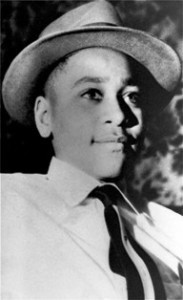
New Smithsonian exhibit shows racism against Emmett Till continues today

By Hamil R. Harris
TriceEdneyWire.com
In the middle of the night, 14-year old Emmett Till was snatched from his great uncle’s home in Drew, Mississippi. Then an angry White mob beat, tortured and then shot Till before they used wire to connect a fan blade to his head to sink his young body to the bottom of the Tallahatchie River.
The brutal lynching of Emmett Till on Aug. 28, 1955 was on the mind of 13-year-old Yolanda Rene King at the March On Washington for Voting Rights rally last Saturday. During her speech, Martin Luther King’s only grandchild asked for a moment of silence in honor of Till, who she said, “was about my age.”
Only blocks away from where she stood, a brand new exhibit was about to pay homage to that same memory. Although thousands have filed past the casket of Emmett Till displayed at the Smithsonian’s Museum of African American History and Culture, a new exhibit was set to open last Friday in “Flag Hall” of the Smithsonian’s Museum of American History that shows the recently bullet-riddled road markers where Till’s body was found. This is desecration that starkly indicates the level of racism and White supremacy still infesting America.
“These signs were part of a long-standing history that has intentionally been suppressed and in some ways attacked,” said Tsione Wolde-Michael, 34, the Smithsonian’s curator for African American Social Justice. She added: “The community has shown its resilience in erecting a new sign every time it is shot up.
“Till’s murder and open-casket funeral became a catalyst for the civil rights movement…And now in what would have been Emmett Till’s 80th year, this vandalized sign demonstrates the ways histories of racism and violence continue into the present. Our Mississippi community partners have continuously risked their lives to commemorate and interpret this history, and we are honored with the trust they have placed in the Smithsonian to steward the sign and bring its story along with Emmett’s to the public.”
The Smithsonian’s National Museum of American History will open “Reckoning with Remembrance: History, Injustice and the Murder of Emmett Till” as a month-long display of the bullet-ridden sign that was placed by the Tallahatchie River in Mississippi in remembrance of Emmett Till, beginning last Friday.
Smithsonian Curator Nancy Bercaw said Jerome G. Little, who died in 2011, pioneered the effort to preserve the Till story and the signs. He was the first African-American to serve as the president of the Tallahatchie County Board of Supervisors.
“The signs were shot up, people defaced them with acid. But every time the Emmett Till Memorial Commission pulled themselves together and raised the funds and put up another sign,” Bercaw said. After Little died, his friend, Jesse Jaynes-Dimming has been working with the Emmett Till Memorial Commission to keep Till’s legacy alive.
Anthea M. Hartig, Elizabeth MacMillan director of the National Museum of American History, said the museum was scheduled to present a program last Thursday entitled, “The Long Battle: The Work of Preserving Emmett Till’s Memory, a Conversation with Community Leaders from Tallahatchie County, Mississippi.”
Rev. Wheeler Parker, a civil rights activist and Till family member and Patrick Weems, executive director of the Emmett Till Interpretive Center in Money, Mississippi, teamed up with curators and officials from the Smithsonian to hold the conversation and present the exhibit which went on public display last Friday. The Museum is located on D.C.’s Constitution Avenue N.W. between 12th and 14th streets. Access information can be found at Americanhistory.si.edu or by calling 202-633-1000.
Wolde-Michael said that In 2019 she and a group of historians traveled across Mississippi looking to learn more about the Emmett Till sign story. The reception was positive toward having the national exhibit. “This is about establishing long-term relationships in the community. This is just the beginning.”
The sentiment is mutual.
“We are thrilled to partner with the Smithsonian National Museum of American History,” said Weems. “The citizens of Tallahatchie County have struggled to keep Till’s memory on the physical and cultural landscape. We are honored that the Smithsonian has taken an interest in this important American story.”
The exhibit is deliberately placed in the museum’s most prominent location, across from the Star-Spangled Banner exhibition at the building’s center. The Till sign works to preserve the memory of an African American boy’s murder while demonstrating the ongoing nature of anti-Black violence in America. A companion webpage was also made available last Friday.
In 2008, the Emmett Till Memorial Commission erected nine historical markers to commemorate Till, but the signs have been stolen, riddled with bullets or thrown in the river. The 317 bullet punctures on the sign collected by the museum, the second of four placed at the river site, serve as a reminder that the racism that caused Till’s death still exists today. The commission erected a new bullet-proof marker in 2019 and donated this historical marker to the museum.
“The National Museum of American History is deeply honored to collaborate with the Tallahatchie community to preserve and present the legacy of Emmett Till,” said Hartig, “The history of racial violence is often erased and highly contested in the battle to define American memory, and this vandalized sign demonstrates the ramifications of ongoing efforts of remembrance and social justice. Racism does not only reside in the past. It inhabits our lived reality.”
The installation of the Till Historical Marker is part of the museum’s new vision outlined in its strategic plan, which is centered in outreach and commitment to communities and provides a place for people to explore the complexity of the country’s shared history.
“The Emmett Till Memorial Commission has been working for 15 years to change the physical and cultural landscape of Tallahatchie County, Mississippi, and the road to remember has not been easy,” said Weems. “So it is with great appreciation that we are partnering with the Smithsonian to honor and remember Emmett Till and the struggle that our community has faced to commemorate his life and legacy and to create the conditions for racial healing.”







